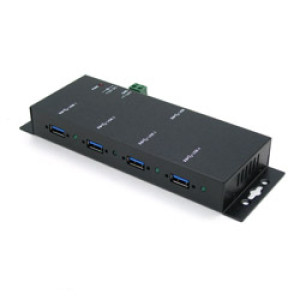Your shopping cart is empty!
MENU

The ease of use of USB sometimes creates challenges. Computers, especially laptops, often don’t have enough ports. Cable length is limited, restricting computer placement, and some legacy hardware uses RS-232 serial rather than USB.
Westward Sales has solutions. Powered USB hubs let multiple devices connect simultaneously to a PC or laptop. A USB-to-Ethernet converter enables data transmission over longer distances, and a USB-to-serial converter allows older equipment to communicate with modern computers.
These are available for both USB 2.0 and 3.0. Even though USB 3.0 is backward compatible, it’s gradually taking over. That’s due to a speed of 5 Gbps as compared with the 480 Mbps of USB 2.0. And, it is happening despite the limited range of USB 3.0 cables. The maximum cable length for USB2.0 is 16’ 5” (10m) while for USB3.0 it’s just 10' (3m).
A USB hub has multiple Type-A (rectangular) receptacles for cables from devices like hard drives, printers, flash drives, cameras, and even data loggers. A single Type-B connection links to a USB port in the computer. USB2.0 provides 500 mA of current that’s shared between the devices on a bus-powered hub. With USB3.0 the maximum current per port is 900 mA.
Consumer-grade hubs lack robustness for industrial environments. An industrial USB hub has a metal enclosure and screw-locking cable connectors to prevent pull-out. A separate power supply is standard; although, it may be unnecessary for a 4-port hub connecting low power consumption devices.
Westward Sales carries industrial-grade hubs supporting both USB2.0 and 3.0. The USB-HUB4K and USB-HUB7K are USB2.0 hubs with 4 and 7 ports respectively. For USB3.0 connectivity, look at the USB-HUB4K3 and USB-HUB3-7K.
Serial interfaces are found in equipment used for access control, Intelligent Transportation Systems, data acquisition, process control, and automation. Older equipment was built with only RS-232 outputs, although RS-422 and RS-485 are not uncommon. Data rates are lower than for USB, so multiple devices can communicate with a PC via a USB-serial converter.
RS-232 has an effective range of 50' (15.2m) but RS-422 and RS-485 can transmit up to 4,000' (1,200m.) Cat5 Ethernet cabling operates over distances up to 328' (100m). Thus, for long-range communication USB signals may be converted into either serial or Ethernet.
At their simplest, these comprise a cable with a male USB connector at one end and a block incorporating a DB9 connector and conversion electronics at the other. The UTS-1110A handles RS-232 to USB conversion while the UTS-1458B does the same for RS-422/485. When isolation is required, the UTS-1461A-SI and UTS-401BK-SI function the same except they offer additional voltage and current input protection.
Similar converters put multiple RS-232 cables into a single USB port. The UTS-402CK has 2 male DB9 connectors, the UTS-404A has 4, UTS-408A has 8 and the UTS-416AK accepts 16 RS-232 inputs.
Westward Sales offers industrial-grade USB hubs, extenders, and isolators designed to maintain stable data communication in demanding environments. These devices provide surge protection, EMI resistance, and wide-temperature operation for SCADA, manufacturing, and field equipment applications. Options include DIN-rail mounting, metal housings, and multi-port configurations.
Contact a Westward Sales specialist to select the industrial USB solution that fits your deployment.